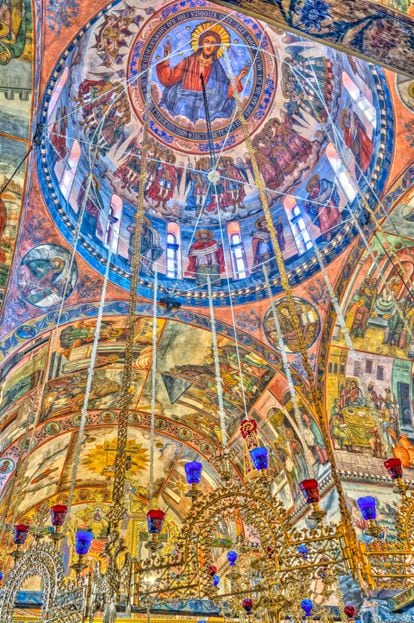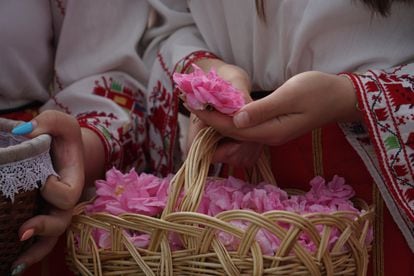Bulgaria is fashionable among Spanish travelers. In addition to its attractive historical-artistic heritage, and its varied beach and mountain offering, is added the curiosity to know a distant European country, with which we had little contact in the past, which has the exotic factor of, due to its history and its geographical location, having been one of the traditional doors to oriental culture. On the other hand, it is a country that is very affordable for our pockets.
Bulgaria offers us to explore its winding roads to discover hidden monasteries and rugged fortresses among lush forests and mountains; impressive frescoes and icons covering the walls of its churches dimly lit by candles; vestiges of the peoples who passed through these lands (Thracians, Greeks, Romans, Goths, Byzantines, Slavs, Ottomans…), and picturesque villas with nineteenth-century mansions in the National Renaissance style, with wavy facades of brightly painted wood and floral decorations, whose owners were rich merchants who traded between east and west. We can enjoy its Black Sea beaches and go hiking or skiing in the Balkan, Pirin, Rila and Rhodope mountains. Taste its consistent gastronomy, which is based on dairy products – yogurts were born in these lands – and its wines, such as those from Melnik.
In the buildings that make up the center of Sofia, the capital, we can get an idea of what its history was like. From the Sofia Monument, where there was a statue of Lenin, we can see the ruins of Roman Serdica next to the small medieval church of Sveta Petka; the Sveta Nedelya Cathedral, Orthodox Christian, the country's majority religion; the Banya Bashi mosque, heritage of 500 years of Ottoman rule; the largest Sephardic synagogue in the world, with a guide who speaks Ladino, a symbol of the important Sephardic community that existed in Bulgaria, and buildings from the communist period that today occupy democratic institutions such as the Presidential Palace, with a colorful changing of the guard every hour, whose inner courtyard houses the oldest church in Sofia, Sveti Georgi, from the 2nd century.
Further ahead are the old Royal Palace, today the National Gallery, and the beautiful Russian church of Saint Nicholas, testimony of the relations with that Russia that helped Bulgaria become independent in 1878. Turning left we reach the church of Saint Sophia, one of the first great Roman basilicas, and the neo-Byzantine Alexander Nevsky Cathedral, seat of the Patriarch of Bulgaria, the highest religious authority. Its interior and the frescoes that cover its walls give it a majestic character. Before leaving Sofia, you must visit the foothills of Mount Vytosha that rises above the city. There is one of the jewels of Bulgaria: the small church of Boyana, a World Heritage Site. The 89 scenes and 240 figures in the frescoes that cover its narrow interior and apse date from the 10th and 11th centuries.
Bulletin
The best travel recommendations, every week in your inbox
RECEIVE THEM
We head to the Rila Monastery, also a World Heritage Site, the largest in the Balkans and one of the most spectacular. Its origin dates back to the 10th century, at the hands of Saint Ivan of Rila, although its constructions and the church's frescoes date back to later. The walled enclosure, with a defensive tower, is nestled in a deep valley, surrounded by steep mountains, oak and beech forests, hermitages, caves, glacial lakes and peaks like Musala, a paradise for hikers. Outside the city walls, it is typical to take a mekitsi ―yogurt bun with icing sugar― and grilled trout in the restaurants in the area.
We arrive in Plovdiv, the cultural capital of the country. The best thing is to let yourself be carried away by its labyrinthine and steep cobbled alleys of the old town, enjoy its impressive Roman theater, the scene of plays and concerts, and discover its churches and old mansions, now converted into hotels and museums. At its foot is the lively Kapana neighborhood, full of bars and restaurants, next to the striking Dzhumaya mosque and part of the stands of a Roman circus that lies under a pedestrian street. In Plovdiv, every time work is done, some archaeological site emerges. For lovers of folk dances, it is recommended Megdana restaurantlocated in an area of nineteenth-century bourgeois Plovdiv.

Two obligatory stops near Plovdiv: the Bashkovo monastery, whose origin dates back to 1083, which has impressive frescoes in its churches and a venerated icon of the virgin, from 1310; and Koprivshtitsa, perhaps the most beautiful town in Bulgaria, full of colorful mansions in which we can see how its inhabitants lived. It is a place of worship for Bulgarians, since the first shot of the failed rebellion of 1876 was fired on the old Kalachev Bridge, which would end two years later in independence from the Ottomans.
We head to the valley of roses and the Thracian kings whose burial mounds dot its colorful plains. Kazanlak is notable for the Thracian archaeological remains of the Iskra Museum and a 4th century BC tomb, a World Heritage Site, which preserves its original frescoes in its vaulted interior. The valley is also important for the traditional cultivation of roses to make cosmetics and perfumes. The best time to visit is between May and June, during the harvest, which is accompanied by popular festivals and dances in traditional attire.

On the way to Veliko-Tarnovo there are several charming places: the Russian Shipka Church, with its golden onion domes; the Etara museum town, which exhibits different types of regional houses; Tryavna, another of the most charming towns in Bulgaria, and the monasteries of Sokolski and Dryanovo.
Veliko-Tarnovo was the medieval capital. Its houses and the Tsarevets fortress are perched on the slopes of the bends of the Yantra River, a panoramic view that can be enjoyed from the terraces of the bars overlooking the Boris Denev art gallery, impressive when surrounded by mist. In the background, the fortress shines in all its splendor with the night lighting. It is crowned by a temple whose interior was decorated in the communist period with murals of biblical scenes and the national imagination. The result is curious.

A few kilometers away, on the complex road to Ruse, is the Transfiguration Monastery, from 1360, with splendid frescoes in its church. We touched the Danube in Ruse, the birthplace of Nobel Prize winner Elías Canetti, in whose center you can see that he had a splendid past. In its surroundings are the unique medieval rock churches of Ivanovo and the Thracian tomb of Svechtari with its sculpted walls, both World Heritage Sites.
We arrive at the Black Sea where Varna, Burgas, Nesebar and Sozopol compete for beach tourism. The old town of Nesebar, a World Heritage Site, stands out on a small fortified peninsula with about twenty Byzantine churches. The most valuable is San Stefano, from the 11th and 13th centuries, due to the beauty of the almost 250 paintings in its interior and narthex, its iconostasis and its capitals. You shouldn't leave the Black Sea without trying their grilled fish in restaurants like Hemingway in Nesebar, overlooking the bay, or Dalyanain the port of Burgas, famous for its black sand beaches.

We finish the journey in Sofia. Nothing better than spending the last night on the lively Vytosha pedestrian avenue, full of restaurants and bars, with live music in the park where it ends. A good way to say goodbye to Bulgaria.
To consider
- Except for the highway that connects Sofia with Burgas, on the Black Sea, and those that lead to Greece and Turkey, the roads are usually narrow and winding, with the pavement not always in good condition and lush vegetation on their edges, and many trucks travel on them. . The particular mountainous terrain does not help either: the Balkan Mountains cross the country like a spine from east to west, dividing it in two.
- It is a fairly safe country, although the poor lighting of its streets can give us a different feeling.
- The head movements to affirm and deny are contrary to ours.
- Its alphabet is Cyrillic; Although in large cities the indications are also in Latin characters, it is interesting to know their equivalents to move around the interior of the country.
- In churches, for both men and women, shoulders, neckline and legs below the knee must be covered.
- It is recommended to attend a mass sung by the priests, and, as the Bulgarians do, buy and light a candle: in this way they help maintain themselves while praying for a family member or a good cause.
- Restaurant kitchens close early at night, so you have to be there before 9:00 p.m.
- Sometimes there is one price for locals and another for tourists, so the bill does not match what is on the menu. The increase is acceptable, just like when they round up the price of some beers.
- You cannot always pay by card, it is advisable to bring national currency, the lev.
- Its old museums need some modernization: with the exception of the Retro Museum in Varna, and not counting the cemetery of communist statues in Sofia, references to the communist and pre-communist period are missing in the history museums.
- The red and white wool bracelets or dolls that hang from trees and plants are martenitsas. They are given to friends and family on March 1 and worn until they are hung on plants when spring emerges.
- Bulgaria is improving its infrastructure since entering the European Union in 2007; for example, Sofia airport is being modernized.
- To find out in some way what life was like in communist Bulgaria, the novel Young talentsby Nikolai Grozny, and the documentary The Beast is Still Alive, by Mina Mileva and Vesela Kazakova, which also reflects how part of the current political class comes from that period. To get to know Sephardic Bulgaria, especially in Plovdiv, Far from Toledoby Angel Wagenstein.
Subscribe here to The Traveler newsletter and find inspiration for your next trips in our accounts Facebook, x and instagram.
#Bulgaria #destination #discover #Sofia


